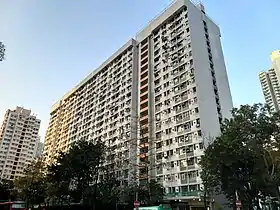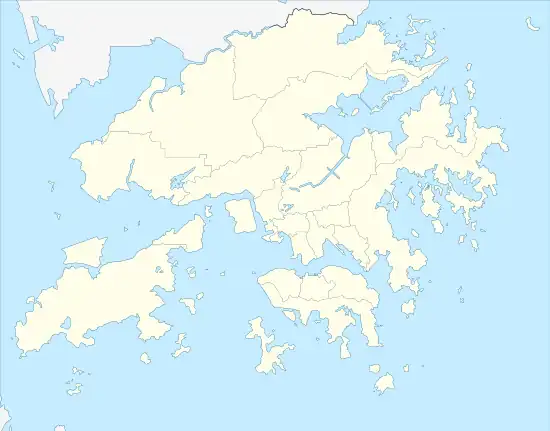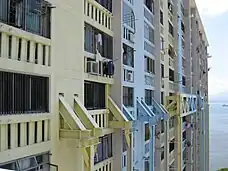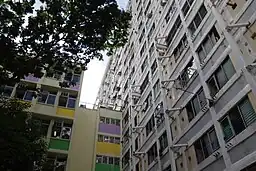 Kwai Yan House (pictured in 2021) is rebuilt from Block 5 of Kwai Fong Estate, one of the first blocks embroiled in the scandal | |
| Native name | 廿六座問題公屋醜聞 |
|---|---|
| Date | 1982–1991 |
| Location | British Hong Kong |
| Type | Construction scandal |
| Cause | Jerry-building |
| Outcome | 26 blocks of housing estate demolished |
| Convicted | 2 |
| Charges | Bribery |
| Verdict | Jail for 3 to 33 months |
26 blocks scandal (Chinese: 廿六座問題公屋醜聞) was a construction scandal in British Hong Kong during the 1980s. A total of 577 blocks of public housing estate was discovered with structural problems, of those 26 were demolished due to the imminent risk of collapse.
Events
In March 1980, blocks 5 and 6 of Kwai Fong Estate, built only eight years prior, were found to suffer from concrete spalling. Investigations concluded that jerry-building damaged the structure of the blocks, as the strength of concrete was significantly lower than the standard.[1][2]
It is later revealed that, on 9 January 1982, the Independent Commission Against Corruption (ICAC) was told that the Kwai Fong Estate was marred by structural issues, such as concrete spalling off and water seepage from wall, with Block 6 as the most serious.[3]
In 1982, Block 6 underwent complete repair whilst occupants were relocated to the Tai Wo Hau Estate in the same Tsuen Wan District, costing HK$50 million. Considering the cost-ineffectiveness and that the issue was quite common at that time, the Housing Department announced in January 1985 that Block 5 would become the first government-built low-cost housing block to be demolished, marking the start of the scandal.[4]
The Government announced on 21 November 1985 that structural problems were found in a total of 577 blocks built between 1982 and 1984 and shall be repaired.[3] 26 housing blocks and a school building were scheduled to be demolished as soon as possible due to the risk of collapse. The Extended Redevelopment Programme was launched in the same year to clear the sub-standard blocks.[5] Tsuen Wan New Town was the most serious, with a total of 11 blocks demolished, impacting around 78,000 residents.
The ICAC decided to launch an investigation of bribery due to the scale of the scandal. The breakthrough of the probe came in 1987 after two criminals agreed to testify as witnesses. Three contractors along with seven current and former officials were charged with bribery. Two contractors were jailed for 33 months and 3 months (received suspended sentences) respectively.[3]
List of affected buildings
Demolished ASAP
| Housing estate | Number of buildings | Built in | Demolished in | Notes |
|---|---|---|---|---|
| Tsz Man Estate | 5 | 1966 | 1989 | Two schools demolished due to structural connection |
| Kwai Fong Estate | 4 | 1971 | 1987, 89 | |
| Kwai Hing Estate | 3 | 1971, 72 | 1988, 89 | One other block demolished due to structural connection |
| Pak Tin Estate | 3 | 1971, 72 | 1989 | |
| Lam Tin Estate | 3 | 1968, 69 | 1988, 91 | Closed in 1989. Two schools, two blocks demolished due to structural connection |
| Shek Lei Estate | 2 | 1966 | 1989 | One other block demolished due to structural connection |
| 1 (School) | 1970 | 1989 | Only school marked as dangerous | |
| Kwai Shing East Estate | 2 | 1973 | 1989 | |
| Tsz Oi Estate | 1 | 1964 | 1989 | A school demolished due to structural connection |
| Sau Mau Ping Estate | 1 | 1968 | 1991 | Closed in 1988. Two blocks demolished due to structural connection |
| Shek Pai Wan Estate | 1 | 1966 | 1988 | |
| Wong Chuk Hang Estate | 1 | 1973 | 1988 |
Other affected buildings

| Housing estate | Block no. | Built in | Demolished in |
|---|---|---|---|
| Valley Road Estate | 16 | 1964 | 2001, 02 |
| Kwai Shing West Estate | 8 | 1977 | Not demolished |
| Yau Tong Estate | 5 | 1971 | 1993 |
| Lei Cheng Uk Estate | 5 | 1955 | 1984 |
| Lek Yuen Estate | 5 | 1975 | Not demolished |
| Tsz Lok Estate | 3 | 1965 | 1990, 92 |
| Hing Wah (II) Estate | 3 | 1976 | Not demolished |
| Wah Fu Estate | 3 | 1968, 70 | 2031, 38 (expected) |
| Choi Wan (I) Estate | 3 | 1980 | Not demolished |
| Lai King Estate | 3 | 1975 | Not demolished |
| Lei Muk Shue Estate | 2 | 1971, 72 | 1995, 2001 |
| Tung Tau Estate | 2 | 1965, 67 | 2003, 13 |
| Oi Man Estate | 1 | 1975 | Not demolished |
| Nam Shan Estate | 1 | 1979 | Not demolished |
| Tai Hing Estate | 1 | 1979 | Not demolished |
| Fuk Loi Estate | 1 | 1963 | Not demolished |
| Kwai Hing Estate | 1 | 1970 | 1992 |
| Tsz Oi Estate | 1 | 1966 | 1992 |
| Mei Tung Estate | 1 | 1974 | 2021 |
Prosecution
Siu Hon-sum, then 62, owner of On Lee Siu Construction Limited, faced eight charges for bribing Lam Or-shum, a worker in the Works Branch five times from February 1970 to December 1973 with a total of HK$50,000 when Ho Man Tin Estate was under construction, and a surveyor in the Work Branch in December 1968 with HK$300 when Kwai Hing Estate was being built. Siu was jailed for 33 months and fined HK$325,000.[6]
Ho Leung, then 70, former owner of Yeu Shing Construction Company Limited, was charged with bribing Lam six times from August 1966 to 1975 with a total of more than HK$45,000 during the construction of Ngau Tau Kok Estate and Lei Muk Shue Estate. Not being charged by ICAC for health problems, Ho testified as a witness, and died in 1991.[7]
Poon Pak-shing, former manager of Great Vast Construction Engineering Limited, faced charges over bribing Lam in 1965 and 1966 with HK$4,000 when building Upper Ngau Tau Kok Estate. Poon was handed three-month jail and suspended for a year, and fined HK$4,000.[7]
Tam Wing-han, former deputy clerk of work in the Works Branch, was found not guilty over receiving bribery. Six government-employed worker, including four retired, were arrested but were not brought to court.
Aftermath
The authorities graded the problematic buildings into four riskiness levels. 26 blocks, found to have imminent risk of collapse and far from the safety standard, were demolished. For the other 551 buildings, some were carried out with stabilisation works. Nevertheless, the Executive Council decided in 1987 that all Resettlement Area and Low Cost Housing blocks were to be knocked down and rebuilt by 2001.[8] The long-term housing strategy, named Comprehensive Redevelopment Programme, was completed in 2010 upon the clearance of Lower Ngau Tau Kok (II) Estate.[9]
References
- ↑ "葵芳邨經不起時間考驗 樓宇出現裂痕". Wah Kiu Yat Po. 1980-03-30. p. 4.
- ↑ "落成七年之葵芳邨公屋 六個單位天花板水坭脫落露鋼筋". Kung Sheung Daily News. 1980-03-03. p. 8.
- 1 2 3 "26 Public Housing Blocks CASE". ICAC. Retrieved 2022-07-04.
- ↑ "房會宣佈因修葺費用巨大 葵芳邨第五座重建 居民安排他遷並給予搬遷津貼". Ta Kung Pao. 1985-01-14. p. 5.
- ↑ "Public Housing Development" (PDF). Housing Authority.
- ↑ "The Queen v Siu Hon Sum". vLex. Retrieved 2022-07-04.
- 1 2 張, 炳良 (2020). 敢教日月換新天:香港反貪先鋒的崢嶸歲月. Chung Hwa Book. p. 240. ISBN 9789888675920.
- ↑ "房委會有關公屋重建文件" (PDF). Hong Kong Housing Authority. Archived from the original (PDF) on 2007-09-30.
- ↑ "Tenants Affected by Estate Clearance". Hong Kong Housing Authority. Retrieved 2022-07-04.
External links
- 香港房屋委員會轄下樓宇結構勘查的經過, 程序及結果報告;香港 房屋署 ;1986
- 樓宇結構勘查簡報 : 截至一九八五年十一月的情況報告;香港 房屋署 ;1986
- 黃, 華輝 (1999). 公屋醜聞──一名記者的追查實錄. Hong Kong: 進一步多媒體有限公司. ISBN 962-8326-22-8.
- "1992年-廉政行動-危樓驚夢". ICAC.
- "1985年鏗鏘集-居安思危". YouTube.
- "1989年-星期一檔案-爛攤子1". YouTube.
- "1989年-星期一檔案-爛攤子2". YouTube.
- "時事追擊-公屋醜聞". YouTube.

